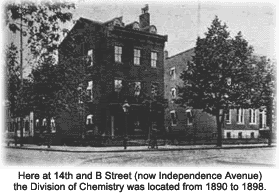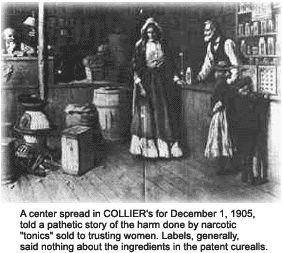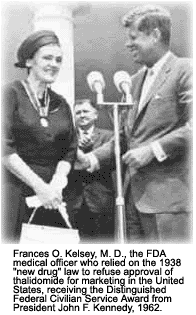The Food and Drug Administration (FDA) is charged with protecting public health by ensuring that foods are safe and pure, cosmetics and other chemical substances harmless, and products safe, effective, and honestly labeled. The FDA is one of the oldest consumer regulatory agencies in the government.
In the 19th century, states exercised control over domestically produced and distributed foods and drugs. That control was markedly inconsistent from state to state.
 In 1862, President Abraham Lincoln appointed chemist Charles M. Wetherill to serve in the new Department of Agriculture. This was the beginning of the Bureau of Chemistry, the forerunner of the Food and Drug Administration.
In 1880, Peter Collier, the chief chemist for the U.S. Department of Agriculture, recommended passage of a national food and drug law, following his own investigations into food adulteration. The bill was overthrown, but during the next quarter of a century, nearly 100 bills were introduced in Congress to regulate the nation's food and drugs.
In 1883, the Bureau of Chemistry's food adulteration studies increased, and they began to campaign for a federal law. The Committee on Food Standards was established in 1898. In 1902 the Bureau of Chemistry was appropriated $5,000 to study chemical preservatives and colors, and their effects on health and digestion.
On June 30, 1906, President Theodore Roosevelt signed the Food and Drugs Act, a mainstay of the Progressive era. This act, which the Bureau of Chemistry was charged to oversee, prohibited the interstate transport of unlawful food and drugs. The principle of the law rested on the regulation of product labeling rather than pre-market approval.
Interpretations of the food provisions in the law led to many court battles. One such battle was a Supreme Court ruling in U.S. v. Johnson, which held that the 1906 Food and Drugs Act did not prohibit false therapeutic claims, but only false and misleading statements about the ingredients or identity of a drug. In 1912, Congress enacted an amendment to overcome the ruling. The amendment prohibited labeling medicines with false therapeutic claims intended to defraud the purchaser.
In 1933, the FDA recommended a complete revision of the 1906 Food and Drugs Act. A new generation of consumer protection organizations assisted in pushing a hesitant Congress to sponsor a bill to replace the old law. The bill was neglected by Congress for five years and finally passed in 1937. The Food, Drug, and Cosmetic Act of 1938, and numerous bills since, have strengthened government control by requiring prior-evidence-of-safety tests and procedures for new drugs, pesticides, and additives and colorings in foods and cosmetics. President Franklin D. Roosevelt signed the Food, Drug, and Cosmetic Act on June 25, 1938.
In 1862, President Abraham Lincoln appointed chemist Charles M. Wetherill to serve in the new Department of Agriculture. This was the beginning of the Bureau of Chemistry, the forerunner of the Food and Drug Administration.
In 1880, Peter Collier, the chief chemist for the U.S. Department of Agriculture, recommended passage of a national food and drug law, following his own investigations into food adulteration. The bill was overthrown, but during the next quarter of a century, nearly 100 bills were introduced in Congress to regulate the nation's food and drugs.
In 1883, the Bureau of Chemistry's food adulteration studies increased, and they began to campaign for a federal law. The Committee on Food Standards was established in 1898. In 1902 the Bureau of Chemistry was appropriated $5,000 to study chemical preservatives and colors, and their effects on health and digestion.
On June 30, 1906, President Theodore Roosevelt signed the Food and Drugs Act, a mainstay of the Progressive era. This act, which the Bureau of Chemistry was charged to oversee, prohibited the interstate transport of unlawful food and drugs. The principle of the law rested on the regulation of product labeling rather than pre-market approval.
Interpretations of the food provisions in the law led to many court battles. One such battle was a Supreme Court ruling in U.S. v. Johnson, which held that the 1906 Food and Drugs Act did not prohibit false therapeutic claims, but only false and misleading statements about the ingredients or identity of a drug. In 1912, Congress enacted an amendment to overcome the ruling. The amendment prohibited labeling medicines with false therapeutic claims intended to defraud the purchaser.
In 1933, the FDA recommended a complete revision of the 1906 Food and Drugs Act. A new generation of consumer protection organizations assisted in pushing a hesitant Congress to sponsor a bill to replace the old law. The bill was neglected by Congress for five years and finally passed in 1937. The Food, Drug, and Cosmetic Act of 1938, and numerous bills since, have strengthened government control by requiring prior-evidence-of-safety tests and procedures for new drugs, pesticides, and additives and colorings in foods and cosmetics. President Franklin D. Roosevelt signed the Food, Drug, and Cosmetic Act on June 25, 1938.
 Enforcement of the new law came rapidly. Within two months of the passage of the act, the FDA began to identify such drugs as sulfas that could not be labeled for safe use directly by the patient, but would require a prescription from a physician. From the 1940s to the 1960s, the abuse of amphetamines and barbiturates required more regulatory effort by FDA than all other drug problems combined. The new law ushered in a flood of new drug applications, more than 6,000 in the first nine years, and 13,000 by 1962.
In 1965, Congress handed over enhanced control by the FDA over amphetamines, barbiturates, hallucinogens, and other drugs of considerable abuse potential in the Drug Abuse Control Amendments. That function was consolidated with similar responsibilities in 1968 under an organization that gave way to the Drug Enforcement Administration.
The FDA was transferred from the Department of Agriculture to the Federal Security Agency in 1940, and in 1953 was again transferred, this time to the Department of Health, Education, and Welfare, which became Health and Human Services.
By the 1960s about half of the food supply was subject to a standard. As food technology changed and the number of possible ingredients, such as fortifying nutrients, grew, the agency developed certain standards for foods, lists of ingredients that could be included in a product. A food that varied from the recipe would have to be labeled an imitation.
Enforcement of the new law came rapidly. Within two months of the passage of the act, the FDA began to identify such drugs as sulfas that could not be labeled for safe use directly by the patient, but would require a prescription from a physician. From the 1940s to the 1960s, the abuse of amphetamines and barbiturates required more regulatory effort by FDA than all other drug problems combined. The new law ushered in a flood of new drug applications, more than 6,000 in the first nine years, and 13,000 by 1962.
In 1965, Congress handed over enhanced control by the FDA over amphetamines, barbiturates, hallucinogens, and other drugs of considerable abuse potential in the Drug Abuse Control Amendments. That function was consolidated with similar responsibilities in 1968 under an organization that gave way to the Drug Enforcement Administration.
The FDA was transferred from the Department of Agriculture to the Federal Security Agency in 1940, and in 1953 was again transferred, this time to the Department of Health, Education, and Welfare, which became Health and Human Services.
By the 1960s about half of the food supply was subject to a standard. As food technology changed and the number of possible ingredients, such as fortifying nutrients, grew, the agency developed certain standards for foods, lists of ingredients that could be included in a product. A food that varied from the recipe would have to be labeled an imitation.
 Changes in the work of the FDA have come rapidly in the past 20 years, shaped in part by political pressure, consumer activism, and the involvement of the food industry. Patient advocacy groups pressed for a law to stimulate industry interest in developing "orphan drugs" for rare diseases, and they also played a role in the agency's development of accelerated techniques for drug approval, such as drugs for AIDS. Congress passed a law that promoted the approval of generic drugs to offer a lower-cost alternative to brand-name pharmaceuticals.
In 1990 Congress passed the Nutrition Labeling and Education Act, which completely reformulated the way food products convey basic nutritional information. And in 1994, after intense pressure and effort by the dietary supplement industry, Congress permitted supplements to carry statements about the role of those products in health, provided they issue a disclaimer that FDA had not evaluated the statements.
Today, the FDA consists of the centers for Drug Evaluation and Research, Biologics Evaluation and Research, Food Safety and Applied Nutrition, Veterinary Medicine, Devices and Radiological Health, and Toxicological Research. The FDA oversees items accounting for 25 cents of every dollar spent by consumers. The agency touches the lives of nearly every American every day. The agency has grown from a single chemist in 1862 to a staff of approximately 9,000 employees and a budget of more than $1.2 billion.
Changes in the work of the FDA have come rapidly in the past 20 years, shaped in part by political pressure, consumer activism, and the involvement of the food industry. Patient advocacy groups pressed for a law to stimulate industry interest in developing "orphan drugs" for rare diseases, and they also played a role in the agency's development of accelerated techniques for drug approval, such as drugs for AIDS. Congress passed a law that promoted the approval of generic drugs to offer a lower-cost alternative to brand-name pharmaceuticals.
In 1990 Congress passed the Nutrition Labeling and Education Act, which completely reformulated the way food products convey basic nutritional information. And in 1994, after intense pressure and effort by the dietary supplement industry, Congress permitted supplements to carry statements about the role of those products in health, provided they issue a disclaimer that FDA had not evaluated the statements.
Today, the FDA consists of the centers for Drug Evaluation and Research, Biologics Evaluation and Research, Food Safety and Applied Nutrition, Veterinary Medicine, Devices and Radiological Health, and Toxicological Research. The FDA oversees items accounting for 25 cents of every dollar spent by consumers. The agency touches the lives of nearly every American every day. The agency has grown from a single chemist in 1862 to a staff of approximately 9,000 employees and a budget of more than $1.2 billion.